Abstract
The tetrasaccharide 3-deoxy-alpha-D-manno-2-octulosonic acid (alpha-KDO) (2----8)-alpha-KDO(2----4)-alpha-KDO(2----6)-beta GlcNAc, a partial structure of chlamydial lipopolysaccharide (LPS) representing a genus-specific epitope, was synthesized and covalently linked to bovine serum albumin, resulting in an artificial glycoconjugate antigen. Mice were immunized with the glycoconjugate to prepare chlamydia-specific monoclonal antibodies. They were selected with chlamydia-specific LPS antigens and the structurally and antigenically related Re-type LPS of a Salmonella minnesota rough mutant. Characterization of the selected antibodies was by (i) hemagglutination of sheep erythrocytes coated with recombinant chlamydia-specific LPS, (ii) inhibition by synthetic polyacrylamide derivatives containing the genus-specific epitope or partial structures thereof, (iii) enzyme immunoassay with recombinant LPS and synthetic bovine serum albumin glycoconjugates as solid-phase antigens, (iv) immunofluorescence of L929 monolayers infected with Chlamydia psittaci or C. trachomatis, and (v) Western immunoblots with glycoconjugates and LPS as the antigen. Two groups of monoclonal antibodies were obtained; the monoclonal antibodies in one group cross-reacted with chlamydial and Re-type LPS, but those of the other group were chlamydia specific. Among the latter, KDO trisaccharide-specific antibodies that had the same epitope specificity as antibodies obtained after immunization with chlamydial elementary bodies were identified; however, they exhibited a more than 100-fold higher affinity. In addition, antibodies that bound preferentially to the 2.8-linked KDO disaccharide were detected, although with lower affinity. The data show that the artificial glycoconjugate antigen is similar to its natural counterpart.
Full text
PDF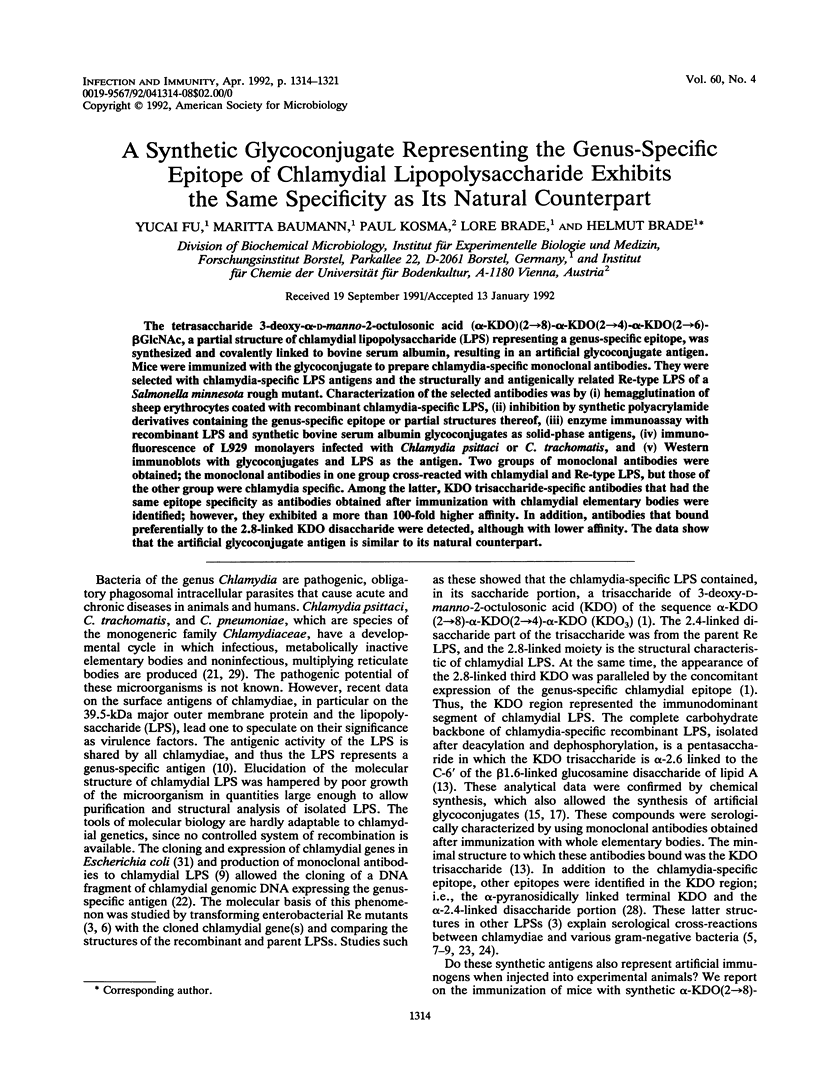
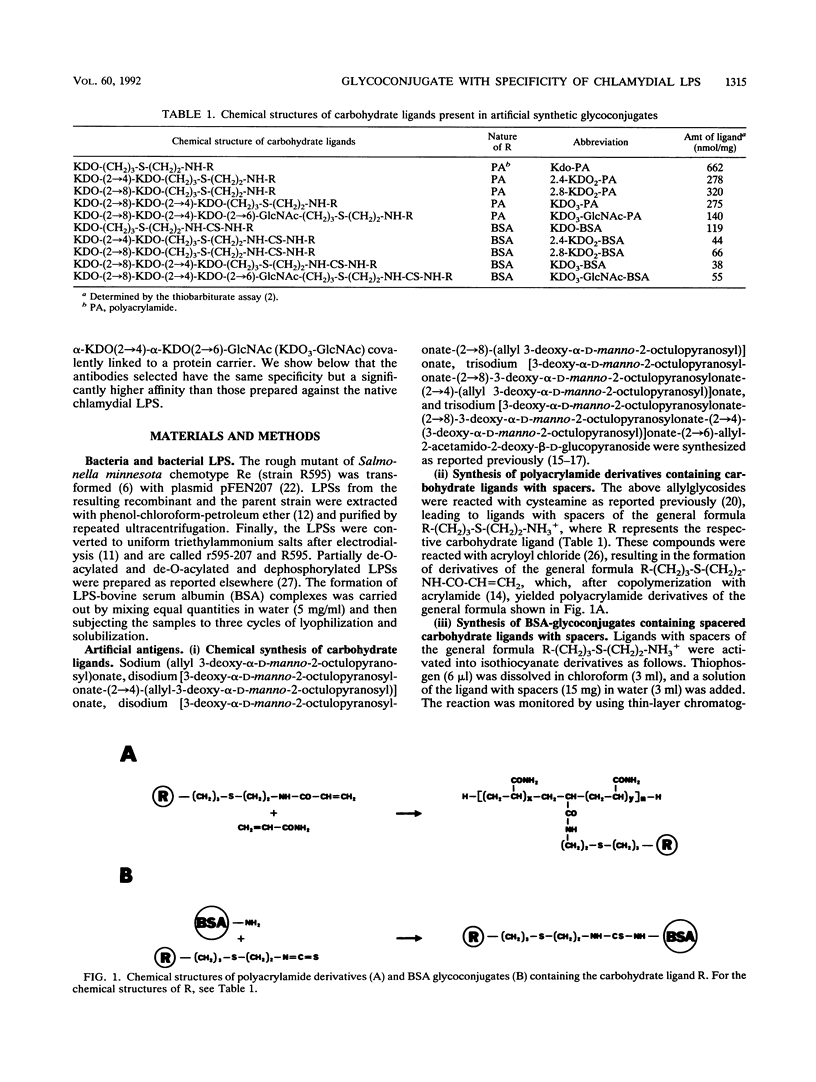
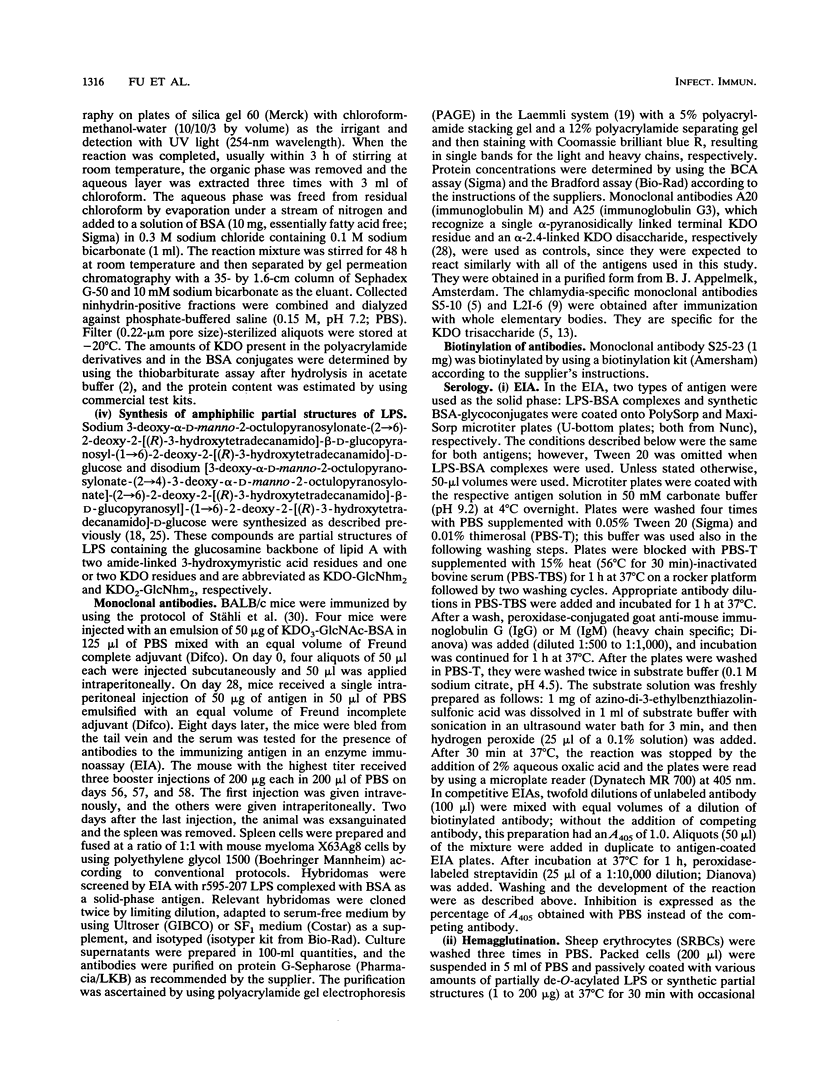

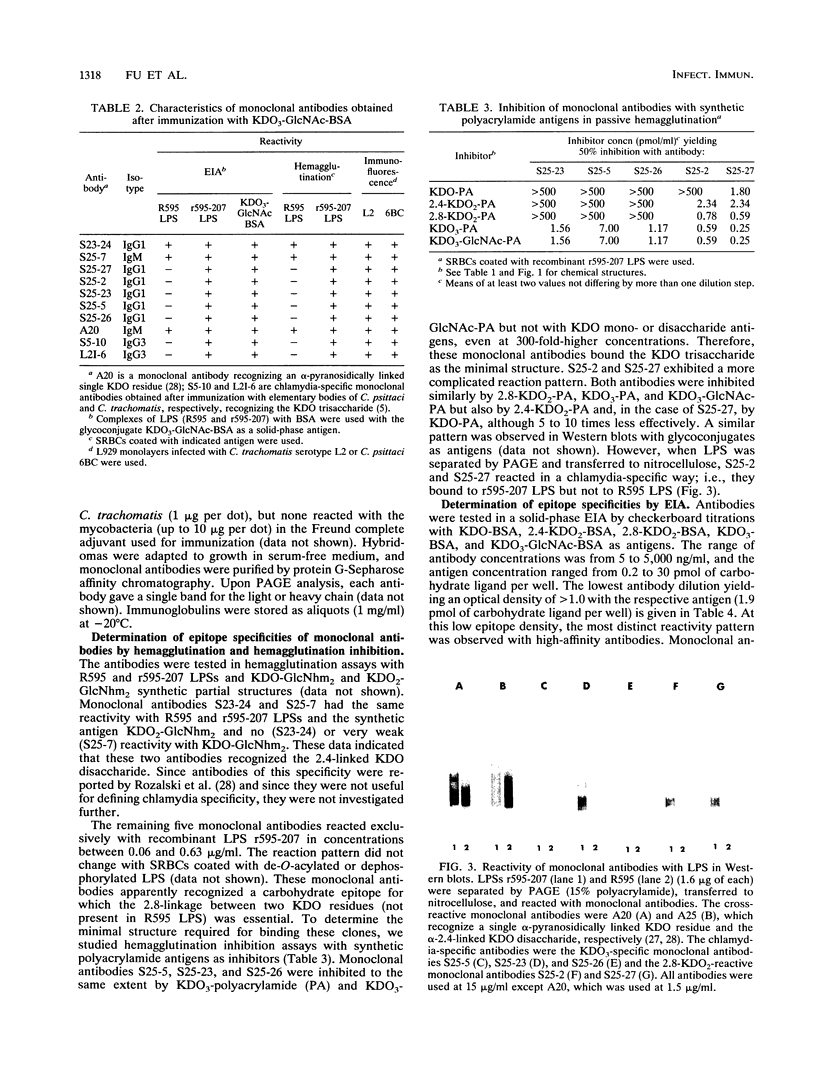
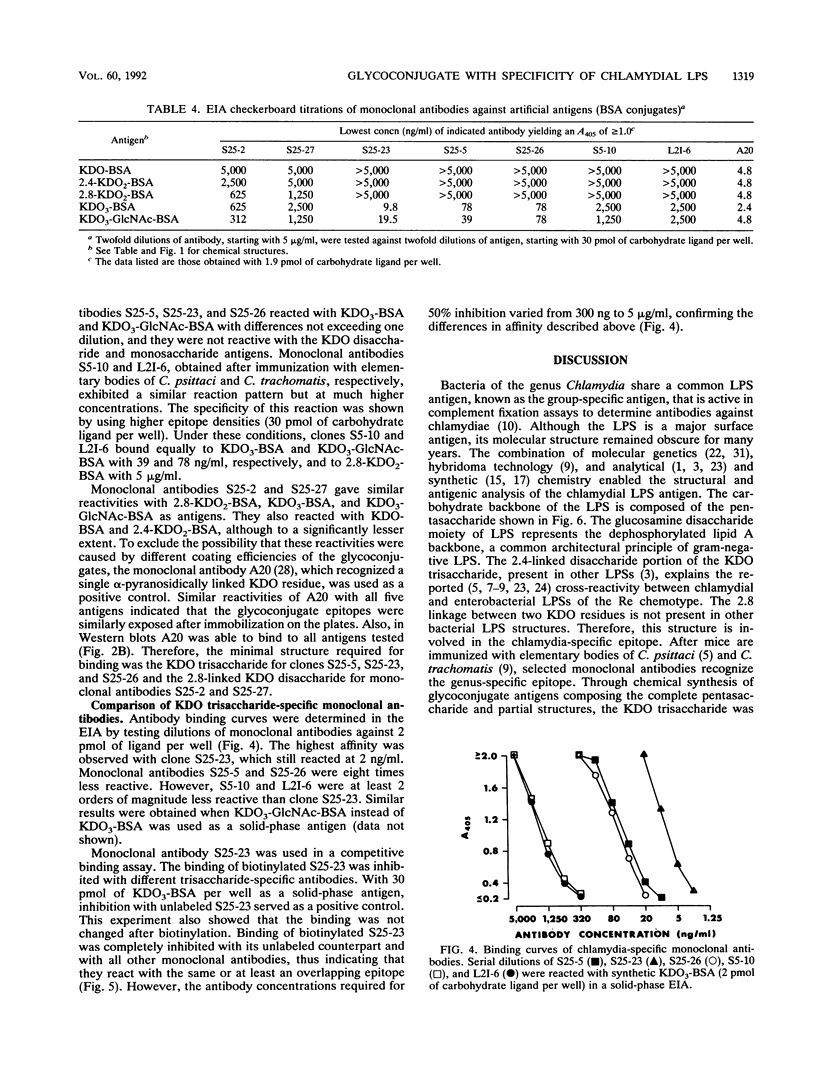
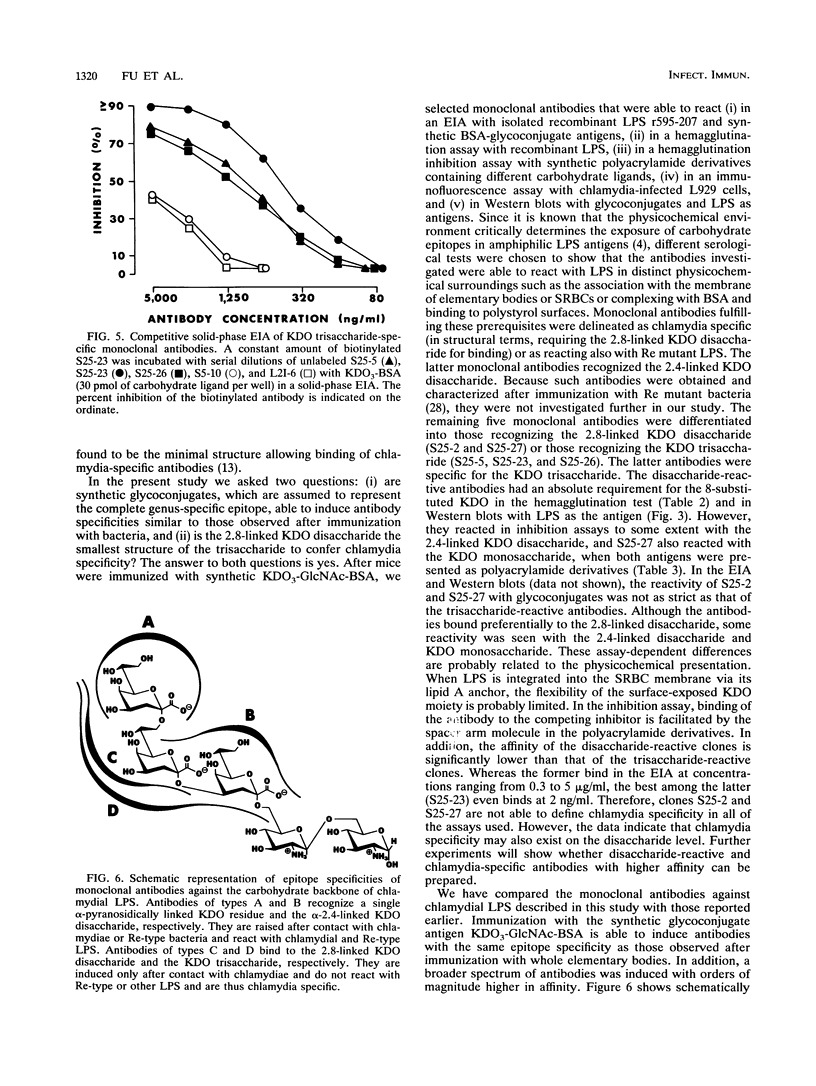
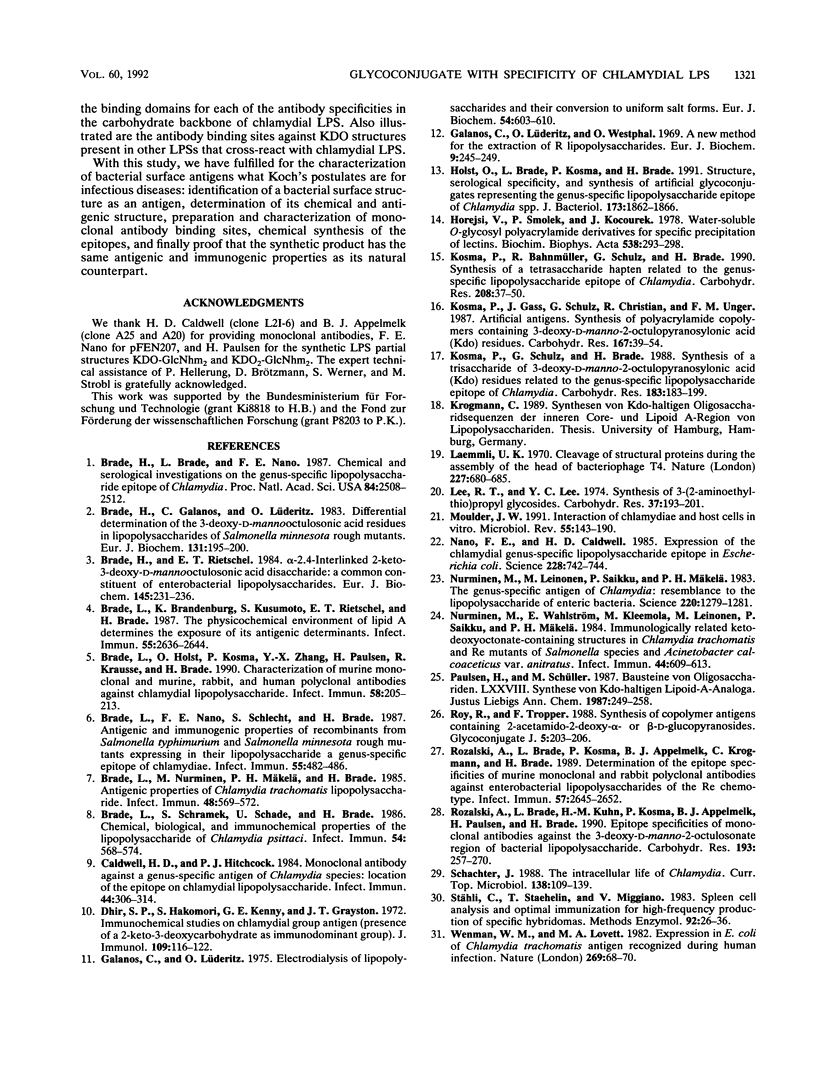
Images in this article
Selected References
These references are in PubMed. This may not be the complete list of references from this article.
- Brade H., Brade L., Nano F. E. Chemical and serological investigations on the genus-specific lipopolysaccharide epitope of Chlamydia. Proc Natl Acad Sci U S A. 1987 Apr;84(8):2508–2512. doi: 10.1073/pnas.84.8.2508. [DOI] [PMC free article] [PubMed] [Google Scholar]
- Brade H., Galanos C., Lüderitz O. Differential determination of the 3-Deoxy-D-mannooctulosonic acid residues in lipopolysaccharides of Salmonella minnesota rough mutants. Eur J Biochem. 1983 Mar 1;131(1):195–200. doi: 10.1111/j.1432-1033.1983.tb07249.x. [DOI] [PubMed] [Google Scholar]
- Brade H., Rietschel E. T. Alpha-2----4-interlinked 3-deoxy-D-manno-octulosonic acid disaccharide. A common constituent of enterobacterial lipopolysaccharides. Eur J Biochem. 1984 Dec 3;145(2):231–236. doi: 10.1111/j.1432-1033.1984.tb08543.x. [DOI] [PubMed] [Google Scholar]
- Brade L., Brandenburg K., Kuhn H. M., Kusumoto S., Macher I., Rietschel E. T., Brade H. The immunogenicity and antigenicity of lipid A are influenced by its physicochemical state and environment. Infect Immun. 1987 Nov;55(11):2636–2644. doi: 10.1128/iai.55.11.2636-2644.1987. [DOI] [PMC free article] [PubMed] [Google Scholar]
- Brade L., Holst O., Kosma P., Zhang Y. X., Paulsen H., Krausse R., Brade H. Characterization of murine monoclonal and murine, rabbit, and human polyclonal antibodies against chlamydial lipopolysaccharide. Infect Immun. 1990 Jan;58(1):205–213. doi: 10.1128/iai.58.1.205-213.1990. [DOI] [PMC free article] [PubMed] [Google Scholar]
- Brade L., Nano F. E., Schlecht S., Schramek S., Brade H. Antigenic and immunogenic properties of recombinants from Salmonella typhimurium and Salmonella minnesota rough mutants expressing in their lipopolysaccharide a genus-specific chlamydial epitope. Infect Immun. 1987 Feb;55(2):482–486. doi: 10.1128/iai.55.2.482-486.1987. [DOI] [PMC free article] [PubMed] [Google Scholar]
- Brade L., Nurminen M., Mäkelä P. H., Brade H. Antigenic properties of Chlamydia trachomatis lipopolysaccharide. Infect Immun. 1985 May;48(2):569–572. doi: 10.1128/iai.48.2.569-572.1985. [DOI] [PMC free article] [PubMed] [Google Scholar]
- Brade L., Schramek S., Schade U., Brade H. Chemical, biological, and immunochemical properties of the Chlamydia psittaci lipopolysaccharide. Infect Immun. 1986 Nov;54(2):568–574. doi: 10.1128/iai.54.2.568-574.1986. [DOI] [PMC free article] [PubMed] [Google Scholar]
- Caldwell H. D., Hitchcock P. J. Monoclonal antibody against a genus-specific antigen of Chlamydia species: location of the epitope on chlamydial lipopolysaccharide. Infect Immun. 1984 May;44(2):306–314. doi: 10.1128/iai.44.2.306-314.1984. [DOI] [PMC free article] [PubMed] [Google Scholar]
- Dhir S. P., Hakomori S., Kenny G. E., Grayston J. T. Immunochemical studies on chlamydial group antigen (presence of a 2-keto-3-deoxycarbohydrate as immunodominant group). J Immunol. 1972 Jul;109(1):116–122. [PubMed] [Google Scholar]
- Galanos C., Lüderitz O. Electrodialysis of lipopolysaccharides and their conversion to uniform salt forms. Eur J Biochem. 1975 Jun;54(2):603–610. doi: 10.1111/j.1432-1033.1975.tb04172.x. [DOI] [PubMed] [Google Scholar]
- Galanos C., Lüderitz O., Westphal O. A new method for the extraction of R lipopolysaccharides. Eur J Biochem. 1969 Jun;9(2):245–249. doi: 10.1111/j.1432-1033.1969.tb00601.x. [DOI] [PubMed] [Google Scholar]
- Holst O., Brade L., Kosma P., Brade H. Structure, serological specificity, and synthesis of artificial glycoconjugates representing the genus-specific lipopolysaccharide epitope of Chlamydia spp. J Bacteriol. 1991 Mar;173(6):1862–1866. doi: 10.1128/jb.173.6.1862-1866.1991. [DOI] [PMC free article] [PubMed] [Google Scholar]
- Horejsí V., Smolek P., Kocourek J. Studies on lectins. XXXV. Water-soluble O-glycosyl polyacrylamide derivatives for specific precipitation of lectins. Biochim Biophys Acta. 1978 Jan 18;538(2):293–298. doi: 10.1016/0304-4165(78)90357-4. [DOI] [PubMed] [Google Scholar]
- Kosma P., Bahnmüller R., Schulz G., Brade H. Synthesis of a tetrasaccharide of the genus-specific lipopolysaccharide epitope of Chlamydia. Carbohydr Res. 1990 Dec 15;208:37–50. doi: 10.1016/0008-6215(90)80083-f. [DOI] [PubMed] [Google Scholar]
- Kosma P., Gass J., Schulz G., Christian R., Unger F. M. Artificial antigens. Synthesis of polyacrylamide copolymers containing 3-deoxy-D-manno-2-octulopyranosylonic acid (KDO) residues. Carbohydr Res. 1987 Sep 15;167:39–54. doi: 10.1016/0008-6215(87)80266-5. [DOI] [PubMed] [Google Scholar]
- Kosma P., Schulz G., Brade H. Synthesis of a trisaccharide of 3-deoxy-D-manno-2-octulopyranosylonic acid (KDO) residues related to the genus-specific lipopolysaccharide epitope of Chlamydia. Carbohydr Res. 1988 Dec 1;183(2):183–199. doi: 10.1016/0008-6215(88)84073-4. [DOI] [PubMed] [Google Scholar]
- Laemmli U. K. Cleavage of structural proteins during the assembly of the head of bacteriophage T4. Nature. 1970 Aug 15;227(5259):680–685. doi: 10.1038/227680a0. [DOI] [PubMed] [Google Scholar]
- Lee R. T., Lee Y. C. Synthesis of 3-(2-aminoethylthio)propyl glycosides. Carbohydr Res. 1974 Oct;37(1):193–201. doi: 10.1016/s0008-6215(00)87074-3. [DOI] [PubMed] [Google Scholar]
- Moulder J. W. Interaction of chlamydiae and host cells in vitro. Microbiol Rev. 1991 Mar;55(1):143–190. doi: 10.1128/mr.55.1.143-190.1991. [DOI] [PMC free article] [PubMed] [Google Scholar]
- Nano F. E., Caldwell H. D. Expression of the chlamydial genus-specific lipopolysaccharide epitope in Escherichia coli. Science. 1985 May 10;228(4700):742–744. doi: 10.1126/science.2581315. [DOI] [PubMed] [Google Scholar]
- Nurminen M., Leinonen M., Saikku P., Mäkelä P. H. The genus-specific antigen of Chlamydia: resemblance to the lipopolysaccharide of enteric bacteria. Science. 1983 Jun 17;220(4603):1279–1281. doi: 10.1126/science.6344216. [DOI] [PubMed] [Google Scholar]
- Nurminen M., Wahlström E., Kleemola M., Leinonen M., Saikku P., Mäkelä P. H. Immunologically related ketodeoxyoctonate-containing structures in Chlamydia trachomatis, Re mutants of Salmonella species, and Acinetobacter calcoaceticus var. anitratus. Infect Immun. 1984 Jun;44(3):609–613. doi: 10.1128/iai.44.3.609-613.1984. [DOI] [PMC free article] [PubMed] [Google Scholar]
- Rozalski A., Brade L., Kosma P., Appelmelk B. J., Krogmann C., Brade H. Epitope specificities of murine monoclonal and rabbit polyclonal antibodies against enterobacterial lipopolysaccharides of the Re chemotype. Infect Immun. 1989 Sep;57(9):2645–2652. doi: 10.1128/iai.57.9.2645-2652.1989. [DOI] [PMC free article] [PubMed] [Google Scholar]
- Rozalski A., Brade L., Kuhn H. M., Brade H., Kosma P., Appelmelk B. J., Kusumoto S., Paulsen H. Determination of the epitope specificity of monoclonal antibodies against the inner core region of bacterial lipopolysaccharides by use of 3-deoxy-D-manno-octulosonate-containing synthetic antigens. Carbohydr Res. 1989 Oct 31;193:257–270. doi: 10.1016/0008-6215(89)85124-9. [DOI] [PubMed] [Google Scholar]
- Schachter J. The intracellular life of Chlamydia. Curr Top Microbiol Immunol. 1988;138:109–139. [PubMed] [Google Scholar]
- Stähli C., Staehelin T., Miggiano V. Spleen cell analysis and optimal immunization for high-frequency production of specific hybridomas. Methods Enzymol. 1983;92:26–36. doi: 10.1016/0076-6879(83)92006-2. [DOI] [PubMed] [Google Scholar]
- Wenman W. M., Lovett M. A. Expression in E. coli of Chlamydia trachomatis antigen recognized during human infection. Nature. 1982 Mar 4;296(5852):68–70. doi: 10.1038/296068a0. [DOI] [PubMed] [Google Scholar]




